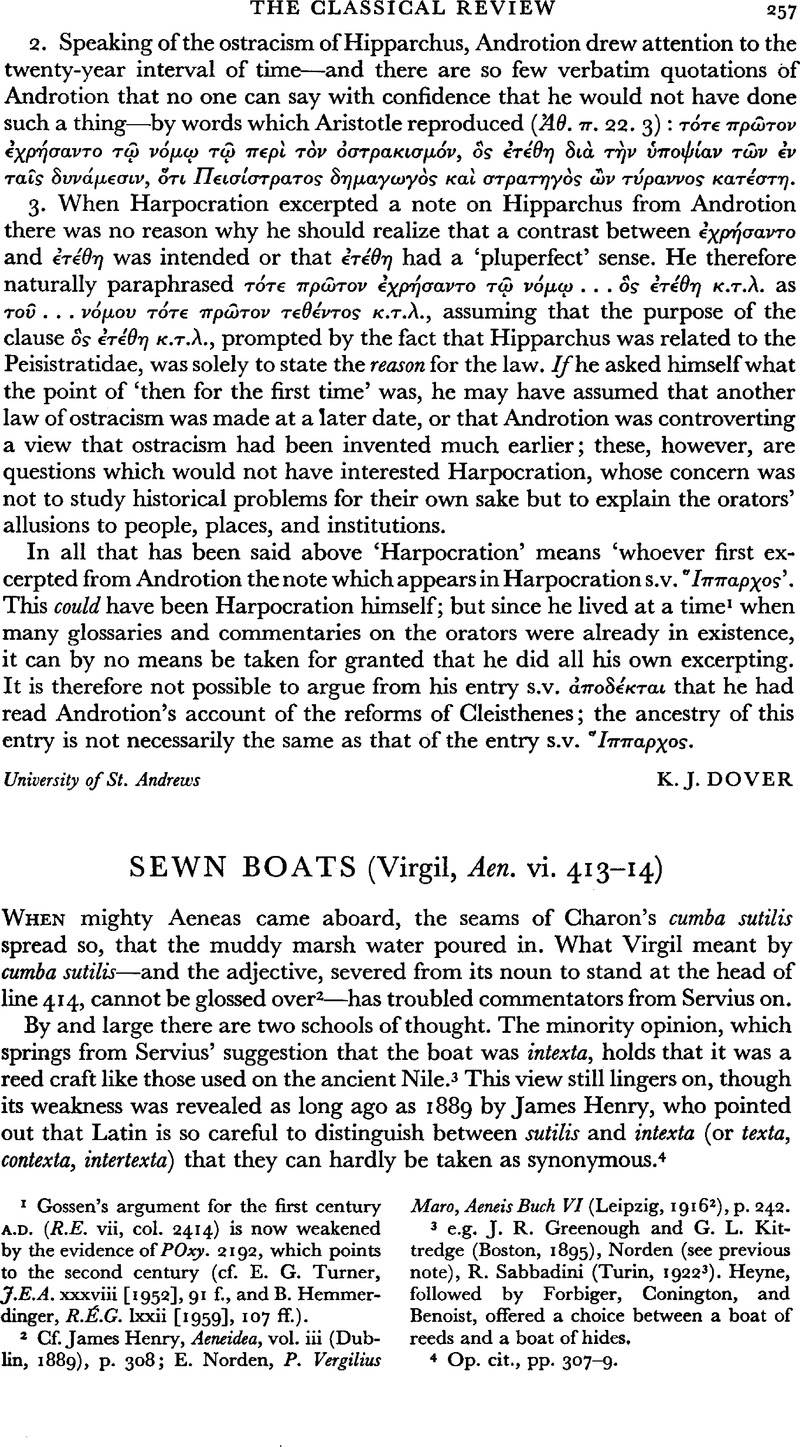Article contents
Sewn Boats (Virgil, Aen. Vi. 413–14)
Published online by Cambridge University Press: 27 February 2009
Abstract

- Type
- Review Article
- Information
- Copyright
- Copyright © The Classical Association 1963
References
page 257 note 2 Cf. Henry, James, Aeneidea, vol. iii (Dublin, 1889), p. 308Google Scholar; Norden, E., P. Vergilius Maro, Aeneis Buch VI (Leipzig, 1916 2), p. 242.Google Scholar
page 257 note 3 e.g. J. R. Greenough and G. L. Kittredge (Boston, 1895), Norden (see previous note), R. Sabbadini (Turin, 19223). Heyne, followed by Forbiger, Conington, and Benoist, offered a choice between a boat of reeds and a boat of hides.
page 257 note 4 Op. cit., pp. 307–9.
page 258 note 1 The view goes at least as far back as Turnebus. Juan Luis de la Cerda repeated it (P. Virgilii Maronis opera, vol. iii [Cologne, 1628], p. 664Google Scholar), citing a number of passages from Latin authors that mention coracles. His followers include C. D. Yonge (London, 1862), T. L. Papillon and A. E. Haigh (Oxford, 1892), T. E. Page (London, 1894), C. Knapp (New York, 1900), H. E. Butler (Oxford, 1920), F. Fletcher (Oxford, 1941).
page 258 note 2 e.g. Norden, Henry (p. 309), Page.
page 258 note 3 Festus 508. 33 = Warmington, E. H., Remains of Old Latin, vol. ii (Loeb Classical Library, London, 1936), Nos. 277–8 (p. 268Google Scholar). Cerda (above, n. 1) noted and quoted this passage, without realizing its implications.
page 258 note 4 See Benoit, F., L'épave du Grand Congloué, xive Supplément à Gallia (Paris, 1961), p. 152Google Scholar, and my review in Am. Journ. Arch. lxvi (1962), 432–3.
page 258 note 5 Cf. Hornell, James, Water Transport Cambridge, 1946), pp. 192–193, 234–7Google Scholar; Hourani, G., Arab Seafaring (Princeton, 1951), pp. 87–98.Google Scholar
page 258 note 6 Cf. Hornell, pp. 187–8, 192.
page 258 note 7 The schnjaka, used in the grounds off Murmansk. An example is on display in the Boat Hall of the Norsk Sjøfartsmusee in Oslo.
page 259 note 1 Aulus Gellius (quoting Varro), xvii. 3: Liburni … plerasque naves loris suebant, Graeci magis cannabo et stuppa ceterisque sativis rebus, a quibus σπ⋯ρτα appellabant; Pliny, N.H. xxvi. 40: et cum sutiles fierent naves [by the early Greeks], lino tamen, non sparto, umquam sutas. Both authors are commenting on Iliad ii. 135 (κα⋯ δ⋯ δο⋯ρα σ⋯σηπε νε⋯νκαι σπ⋯ρτα λ⋯λυνται) and assume that Homer is talking not of the ships' rigging but of the twine that bound plank to plank; cf. W. H. S. Jones's note on the passage in the Loeb edition of Pliny. Hourani (p. 258, n. 5), though he quotes Virgil's lines as proof of the leakiness of sewn boats, seems unaware that they were ever used in the Mediterranean; cf. his n. 86 on p. 93 and his remarks on the origin of the sewn boat on pp. 93–94.
- 4
- Cited by




